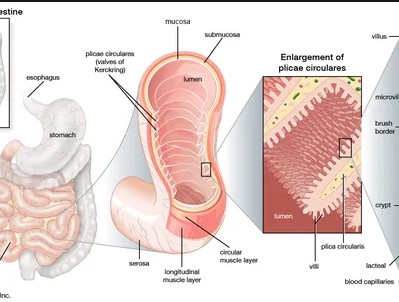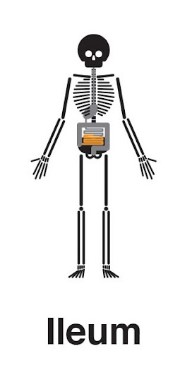The distinction between ilium and ileum is a prime example of how nuanced the field of human anatomy can be. Despite their similar spelling, these terms refer to vastly different parts of the body, each with its unique functions and significance. The ilium is a component of the pelvic bone, while the ileum is the final section of the small intestine. Their phonetic similarity often leads to confusion, not just among the lay public but occasionally within the medical community as well.
The ilium is part of the hip bone, contributing to the pelvis structure and providing support for the body’s weight in sitting and standing positions. On the other hand, the ileum plays a critical role in the digestive system, absorbing nutrients from the food we eat into the bloodstream. These distinctions underscore the ilium’s involvement in the skeletal system and the ileum’s function within the digestive tract.
Understanding the differences between the ilium and ileum goes beyond their anatomical locations. It involves recognizing the separate roles they play in the body’s overall health and function. The ilium, with its contribution to the pelvic girdle, facilitates locomotion and supports the abdominal organs. Conversely, the ileum’s efficient absorption of vital nutrients and its role in immune defense highlight its importance in the gastrointestinal system.

Anatomy Basics
Bone vs. Bowel
At the core of understanding human anatomy is distinguishing between various systems that operate within the body. Two primary systems that often come into focus due to their essential functions and complex structures are the skeletal system and the digestive system. The skeletal system provides structural support, protection for internal organs, and the framework necessary for movement. It comprises bones, joints, cartilages, and ligaments. On the other hand, the digestive system is responsible for the breakdown of food, absorption of nutrients, and elimination of waste. It includes the mouth, esophagus, stomach, intestines, and accessory organs like the liver and pancreas.
Ilium Overview
Location and Function in the Skeletal System
The ilium is the broad, wing-shaped part of the pelvic bone. It plays a crucial role in the skeletal system by forming the upper part of the hip bone and contributing significantly to the structure of the pelvis. The ilium serves as a foundation for the weight of the body, especially in activities involving the lower limbs, such as standing and walking. Its large surface area provides attachment points for numerous muscles and ligaments, facilitating movement and stability.
Connection to the Pelvis
The pelvis is a basin-shaped structure that connects the spine to the lower limbs. The ilium, along with two other bones – the ischium and pubis – forms a crucial part of the pelvis. The ilium’s connection to the pelvis is vital for several functions, including supporting the abdominal organs, providing protection, and enabling powerful leg movements. This interconnection highlights the ilium’s importance in locomotion and posture.
Ileum Overview
Location and Function in the Digestive System
The ileum is the third and final portion of the small intestine, extending from the jejunum to the large intestine. It plays an indispensable role in the digestive system, primarily focusing on the absorption of nutrients and minerals. The ileum is intricately designed with folds, villi, and microvilli to maximize the surface area for absorption. It is in the ileum that vital nutrients, such as vitamin B12, bile acids, and remaining products of digestion that were not absorbed in the jejunum, are absorbed into the bloodstream.
Role in Nutrient Absorption
The absorption process in the ileum is facilitated by its extensive surface area and the presence of specialized cells capable of transporting different nutrients. This segment of the intestine is also crucial for reabsorbing bile acids, which are recycled back to the liver for the digestion of fats. The effective absorption of nutrients in the ileum is vital for maintaining the body’s nutritional status and overall health.
Key Differences
Structure
Physical Characteristics of the Ilium
The ilium’s structure is marked by its large, wing-like shape that forms a significant part of the pelvic bone. Its surface is divided into two parts: the body, which contributes to the acetabulum (the socket for the hip joint), and the ala, or wing, which provides attachment points for muscles. The ilium’s crest, the upper border, is a notable feature for muscle attachment and is easily palpable under the skin.
Physical Characteristics of the Ileum
In contrast, the ileum’s structure is designed for optimal nutrient absorption. It is characterized by its tubular form and measures approximately 3.5 meters in length in a living person. The ileum’s inner surface is highly convoluted, featuring numerous folds, villi, and microvilli. These structures significantly increase the surface area, enhancing the ileum’s ability to absorb nutrients effectively.
Function
Role of the Ilium in the Body
The primary function of the ilium is to support the body’s structure and facilitate movement. It is integral to the stability and function of the pelvic girdle, serving as an attachment point for muscles and ligaments that move the hip and legs. The ilium also plays a crucial role in protecting internal organs by forming part of the pelvic cavity.
Role of the Ileum in the Body
The ileum, on the other hand, is essential for the digestive process, specifically in the absorption of nutrients and minerals. It concludes the nutrient absorption process started in the earlier segments of the small intestine. The ileum also has a role in the immune system, containing Peyer’s patches, which are aggregates of lymphoid tissue that monitor intestinal bacteria populations and prevent the growth of pathogenic bacteria in the intestines.
Location
Anatomical Position of the Ilium
The ilium is located in the pelvic region, forming the upper part of the hip bone. It is situated posteriorly and laterally, articulating with the sacrum at the sacroiliac joint and connecting with the other pelvic bones to form the acetabulum.
Anatomical Position of the Ileum
The ileum is positioned in the abdominal cavity, extending from the end of the jejunum to the ileocecal valve, where it joins the large intestine. Its placement allows it to effectively carry out its role in nutrient absorption, situated strategically within the digestive tract to maximize the process before the chyme moves into the large intestine for water absorption and feces formation.
Comparative Analysis
In Medical Diagnosis
How Misinterpretation Can Affect Diagnosis
Misinterpreting the ilium for the ileum (or vice versa) can significantly impact medical diagnoses. Given the distinct roles and locations of these structures, confusing them can lead to an inaccurate understanding of a patient’s symptoms or the results of imaging studies. For example:
- Misdiagnosing digestive issues: Symptoms related to the ileum, such as Crohn’s disease, might be incorrectly attributed to issues in the pelvic region if the ilium is mistakenly thought to be involved.
- Bone versus bowel conditions: Misinterpreting pain originating from the ilium (perhaps due to a fracture or osteoarthritis) could be mistakenly pursued as a gastrointestinal issue related to the ileum, leading to unnecessary gastroenterological evaluations.
In Surgery
Surgical Considerations and Implications
The precise identification of the ilium and ileum is critical in surgical planning and intervention. The differences in surgical approaches, potential complications, and postoperative care are stark, emphasizing the need for accurate anatomical knowledge.
- Pelvic surgeries: Operations involving the ilium, such as hip replacement or pelvic fracture repair, require an understanding of the skeletal structure and the relationships with surrounding soft tissues.
- Intestinal surgeries: Surgical interventions on the ileum, like resections for Crohn’s disease, demand a thorough knowledge of the digestive tract’s anatomy, the ileum’s specific vascular supply, and its role in absorption to preserve as much functionality as possible.
In Treatment and Care
Treatment Approaches for Issues Related to the Ilium and Ileum
Effective treatment relies on accurately identifying the source of a problem, which means distinguishing between issues related to the ilium and those associated with the ileum.
- For ilium-related conditions, treatments may include physical therapy, pain management strategies, or surgical interventions to address fractures or deformities affecting the pelvic structure and stability.
- For ileum-related conditions, medical treatments often focus on managing inflammation, infection, or obstruction within the digestive tract, utilizing medication, dietary adjustments, or surgery to remove diseased segments.
Common Confusions
Spelling and Pronunciation
Clarification and Tips to Remember
The close spelling and pronunciation of “ilium” and “ileum” are sources of frequent mix-ups. Here are some tips to help differentiate them:
- Ilium (with an “i”) pertains to the bone; remember it as “I lie on my hips,” linking it to the skeletal system.
- Ileum (with an “e”) relates to the bowel; think of the “e” in “eat” to connect it with the digestive system.
Clinical Implications
Impact of Confusion in Medical Settings
The confusion between ilium and ileum can have serious implications in clinical settings:
- Medical records: Incorrect documentation can lead to miscommunication among healthcare providers, potentially affecting patient treatment plans and outcomes.
- Patient education: Misinforming patients about their diagnosis or treatment plan due to a mix-up between these terms can lead to misunderstandings about their health condition, affecting compliance and satisfaction.
- Research and learning: For students and professionals, misunderstandings can propagate misinformation, potentially impacting clinical knowledge and practice.
FAQs
What is the ilium?
The ilium is the uppermost and largest part of the hip bone, forming a crucial component of the pelvic girdle. It serves as a vital structure for attachment of various muscles and ligaments, playing a key role in supporting the body’s weight and facilitating movement. The ilium’s broad, wing-shaped surface also contributes significantly to the stability of the pelvic region.
How does the ileum function in digestion?
The ileum, being the last part of the small intestine, is primarily responsible for the absorption of nutrients and minerals that were not absorbed by the jejunum. It contains specialized structures that increase its surface area, making it highly efficient in absorbing vitamin B12, bile salts, and other essential nutrients into the bloodstream. The ileum also plays a role in the immune system by housing a large number of lymph nodes.
Why do people confuse ilium with ileum?
The confusion between ilium and ileum often stems from their similar pronunciation and spelling. Both terms are derived from Latin and share a common linguistic root, but they refer to entirely different parts of the body. This phonetic similarity can lead to misunderstandings, particularly among those who are not familiar with medical terminology or the detailed anatomy of the human body.
Conclusion
In conclusion, the differentiation between ilium and ileum is a fundamental aspect of human anatomy that emphasizes the complexity and specificity of the body’s structure. The ilium’s role in the skeletal system as part of the pelvis contrasts sharply with the ileum’s critical function in the digestive system. Acknowledging these distinctions not only enhances our understanding of human anatomy but also aids in the accurate communication within medical and educational contexts.
Understanding these differences is crucial not just for medical professionals but also for individuals seeking to gain a deeper insight into how their body functions. As we navigate through the complexities of human anatomy, appreciating the unique characteristics and roles of structures like the ilium and ileum can enrich our knowledge and foster a greater appreciation for the intricacies of our own bodies.

